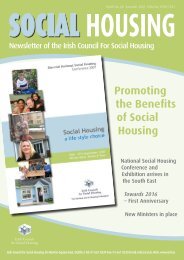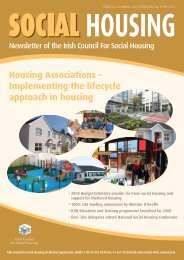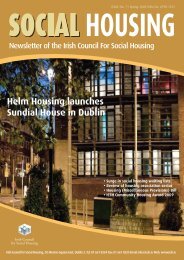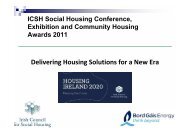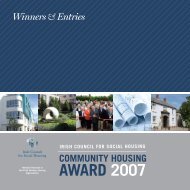National Housing Strategy for People with a Disability 2011 - 2016
National Housing Strategy for People with a Disability 2011 - 2016
National Housing Strategy for People with a Disability 2011 - 2016
Create successful ePaper yourself
Turn your PDF publications into a flip-book with our unique Google optimized e-Paper software.
Appendix 4Definition of ‘<strong>Disability</strong>’A single definition of disability is difficult to compile due to its broad nature. The <strong>Disability</strong>Act 2005 defines a disability as, in relation to a person, means a substantial restriction in thecapacity of the person to carry on a profession, business or occupation in the State or toparticipate in social or cultural life in the State by reason of an enduring physical, sensory,mental health or intellectual impairment. The TrinityHaus research report uses this as itsdisability definition.In the 2006 CSO Census, data on disability was derived from answers to questions 15 and16 of the census questionnaire. Question 15 was a five-part question that asked about theexistence of the following long lasting conditions: (a) blindness, deafness or a severe visionor hearing impairment (sensory disability), (b) a condition that substantially limits one ormore basic physical activities such as walking, climbing stairs, reaching, lifting or carrying(physical disability), (c) a learning or intellectual disability, (d) a psychological or emotionalcondition and (e) other, including any chronic illness.If a person answered YES to any of the parts of Q15, they were then asked to answerQuestion 16. This question was also a five-part question that asked whether an individualhad a difficulty doing any of the following activities: (a) learning, remembering orconcentrating (mental disability); (b) dressing, bathing or getting around inside the home(self-care disability); (c) going outside the home alone to shop or visit a doctor’s surgery(going outside the home disability); (d) working at a job or business or attending school orcollege (employment disability) and (e) participating in other activities, such as leisure orusing transport.Individuals were classified as having a disability if they answered YES to any part of theabove two questions, including in particular if they ticked YES to any of the parts of Q16even though they may not have ticked YES to any of the parts of Q15.The <strong>National</strong> <strong>Disability</strong> Survey questionnaires covered a broader range of difficulties thanhad been possible to include in the Census. The NDS included nine different disabilitiesincluding speech, pain and breathing, which were not specifically mentioned in the Census.Each section began <strong>with</strong> at least one filter question to determine the level of disability (ifany) experienced by the respondent <strong>for</strong> each disability type. In most cases, a person wasclassified as having a disability if they indicated that they had a moderate or more severelevel of difficulty. For 2 categories (intellectual and learning difficulties and emotional,psychological and mental health difficulties), persons responding <strong>with</strong> “Just a little difficulty”were also classified as having a disability.149149



